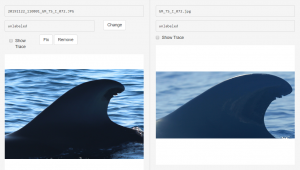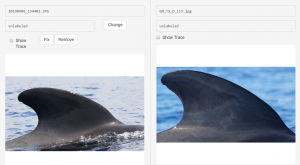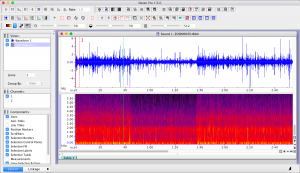What Do Marine Biologists Do Now that They Are Stranded on Land?
Amid the current Covid-19 crisis, BIOSEAN ceased all tours and surveys in compliance with the Spanish government’s lockdown guidelines and for the safety of our guests and team members. We were happy to do our part to prevent the spread of the coronavirus and to protect the residents of Tenerife, the island we call “our home”. Unfortunately, this means we have not been out on the water at all during these past few months. So, what do marine biologists do now? what is it we do exactly?
Photo Identification
One of our onshore projects is the continuation of our data analysis for ongoing research projects, most notably, our photo-identification work.
Here you can see some of our work with fin identification! Each dorsal fin is completely unique to each pilot whale, allowing us to keep track of individuals. When we compare the photos we take (on the left side) to the photos from the catalog (on the right side), we can find out who we have seen on our surveys. In these pictures, we have identified Carlos (top) and Pablo (bottom). Photo-identification allows us to learn so much about pilot whales, such as movement patterns, calving intervals, age, and family structure!



We are also working on identifying new whales that have not been photographed before. This work is so important, as identifying more pilot whales helps give us a more precise estimate of the population here in Tenerife, but also helps us better understand their social interactions. Here you can see a new whale that we have photographed that did not match any in the existing catalog!
What Do Marine Biologists Do Now? Acoustic Analysis
In addition to our photo-identification work, we have also been working hard on our acoustic analysis. During our surveys, we collect acoustic recordings of the cetaceans we encounter, the most common of which is the short-finned pilot whale (Globicephala macrorhynchus). We have been going over these recordings to examine the effects of boat noise on the acoustic behavior of the pilot whales with Roehampton University student Kayla-May Summers, who interned with us over the summer of 2019.

This project is of special importance in this area of Tenerife as it has a high degree of marine traffic from whale-watching boats, recreational vehicles, and cargo/ferry ships. It is important to understand how this noise pollution is affecting our marine life, so that we may better address the issue. She will be presenting this project next month as her final dissertation for her bachelor’s degree. Good luck Kayla!
New Collaborations
We are also thrilled to announce a new collaboration that we have been working on! We have been selected by Ph.D. candidate Andreia de Sousa from the University of Lisbon to serve as Macronesian cetacean experts on a project examining the effects of climate change on the whale watching industry. This particular project is a part of the larger initiative SOCLIMPACT, a venture set up by the European Union, aimed at modeling downscaled climate change effects and their socioeconomic impacts in European islands. We are honored to be able to contribute to this project and create positive change in the EU and throughout the globe as we help tackle climate change.
While we have loved our work at the office, we are very excited to get back out on the water to gather even more data and adventure. We can’t wait for you to join us out on the ocean!